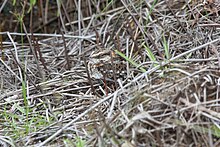White-tailed nightjar
| White-tailed nightjar | |
|---|---|

| |
| Scientific classification | |
| Kingdom: | Animalia |
| Phylum: | Chordata |
| Class: | Aves |
| Order: | Caprimulgiformes |
| Family: | Caprimulgidae |
| Genus: | Hydropsalis |
| Species: | H. cayennensis
|
| Binomial name | |
| Hydropsalis cayennensis Gmelin, 1789
| |

| |
The white-tailed nightjar (Hydropsalis cayennensis) is a species of nightjar in the family Caprimulgidae. It is found in the "ABC Islands", Brazil, Colombia, Costa Rica, Ecuador, French Guiana, Guyana, Martinique, Panama, Suriname, Trinidad and Tobago and Venezuela.[2]
Taxonomy and systematics[]
The white-tailed nightjar was originally described as Caprimulgus cayennensis. Later it was placed in genus Thermochalcis that was later still absorbed back into Caprimulgus. DNA analyses now place it firmly in Hydropsalis, though there is some evidence that one or more of its subspecies might be separate species.[3][4]
The six subspecies of white-tailed nightjar are:[2]
- H. c. albicauda Lawrence (1875)
- H. c. aperta J.L. Peters (1940)
- H. c. cayennensis Gmelin (1789)
- H. c. insularis Richmond (1902)
- H. c. leopetes Jardine & Selby(1830)
- H. c. manati (1963)
Description[]
The white-tailed nightjar is 20 to 22.5 cm (7.9 to 8.9 in) long. Males weigh 33 to 40 g (1.2 to 1.4 oz) and females 32 to 38 g (1.1 to 1.3 oz). Males of the nominate subspecies have grayish brown uppersides with brown to blackish brown speckles and streaks. Their face has a white or buffy supercilium and "moustache". The hindneck has a broad tawny buff collar. The wings are generally grayish to blackish brown with tawny and buffy markings. A white band shows on both the spread and folded wing. The tail appears slightly forked; all but the innermost pair of feathers are partially to completely white. The chin and throat are white. The breast is buff with a cinnamon tinge, brown bars, and bold white spots. The belly and flanks are white with a pale buff wash. The nominate females are darker overall. They do not have white on the wings or tail. The throat is buffy, the breast brownish, and the belly buff with brown bars.[4]
H. c. albicauda is similar to the nominate, but the male's belly has a strong buff tinge and the female's underparts are dark brownish buff. H. c. aperta has a longer wing and tail than the nominate. It is similar to albicauda though the female's upper- and underparts are darker. H. c. insularis is paler than the nominate and possibly smaller. Its upperparts, especially the crown, are buffier. H. c. leopetes is similar to the nominate, but the buff of its collar and other markings is richer. The male's underparts are darker and the female's upperparts paler. H. c. manati is darker than the nominate and has less white in the tail.[4]
Distribution and habitat[]
The subspecies of white-tailed nightjar are distributed thus:[2][4]
- H. c. albicauda, Costa Rica, Panama, and northern Colombia
- H. c. aperta, Colombia's Cauca Valley and northwestern Ecuador
- H. c. cayennensis, eastern Colombia through southern Venezuela and the Guianas into northern Brazil
- H. c. insularis, northeastern Colombia, northern Venezuela, and the "ABC Islands" of Aruba, Bonaire, and Curaçao
- H. c. leopetes, Trinidad and Tobago
- H. c. manati, Martinique
The white-tailed nightjar is a bird of open landscapes such as savanna, pastures, scrubby grasslands, and hillsides with scattered bushes and thickets.[4]
Behavior[]
Feeding[]
The white-tailed nightjar is nocturnal. It mostly forages by sallying from the ground or perches but also will hunt in flight low over open grasslands. Its diet is insects but is not known in detail. It roosts on the ground during the day.[4]
Breeding[]
The white-tailed nightjar's breeding seasons have not been well defined but are known to vary across its range. Males make a wing-clapping display. The clutch size is two; the eggs are laid directly on the ground and only the female incubates them.[4]
Vocalization[]
The white-tailed nightjar's song is "a high, thin pt-cheeeeeeeee, the second note a long-drawn-out, rising whistle that falls slightly at end." The male sings from dusk well into the night during breeding season. Calls include "a scratchy wheer in flight" and "a thin tic-tic" when flushed from a roost.[4]
Status[]
The IUCN has assessed the white-tailed nightjar as being of Least Concern. It has a large range and large population, though the latter is believed to be decreasing. No specific threats have been identified except on Martinique, where habitat destruction and introduced predators are cause for concern.[1][4]
References[]
- ^ a b BirdLife International (2020). "White-tailed Nightjar Hydropsalis cayennensis". IUCN Red List of Threatened Species. 2020. Retrieved 8 October 2021.
- ^ a b c Gill, F.; Donsker, D.; Rasmussen, P. (July 2021). "IOC World Bird List (v 11.2)". Retrieved July 14, 2021.
- ^ Remsen, J. V., Jr., J. I. Areta, E. Bonaccorso, S. Claramunt, A. Jaramillo, D. F. Lane, J. F. Pacheco, M. B. Robbins, F. G. Stiles, and K. J. Zimmer. Version 24 August 2021. A classification of the bird species of South America. American Ornithological Society. https://www.museum.lsu.edu/~Remsen/SACCBaseline.htm retrieved August 24, 2021
- ^ a b c d e f g h i Ferraro, M. M. (2020). White-tailed Nightjar (Hydropsalis cayennensis), version 1.0. In Birds of the World (T. S. Schulenberg, Editor). Cornell Lab of Ornithology, Ithaca, NY, USA. https://doi.org/10.2173/bow.whtnig1.01 retrieved October 8, 2021
- IUCN Red List least concern species
- Nightjars
- Hydropsalis
- Birds of Costa Rica
- Birds of Panama
- Birds of the Netherlands Antilles
- Birds of the Caribbean
- Birds of Barbados
- Birds of Colombia
- Birds of Venezuela
- Birds of Trinidad and Tobago
- Birds of the Guianas
- Birds described in 1789
- Taxa named by Johann Friedrich Gmelin

